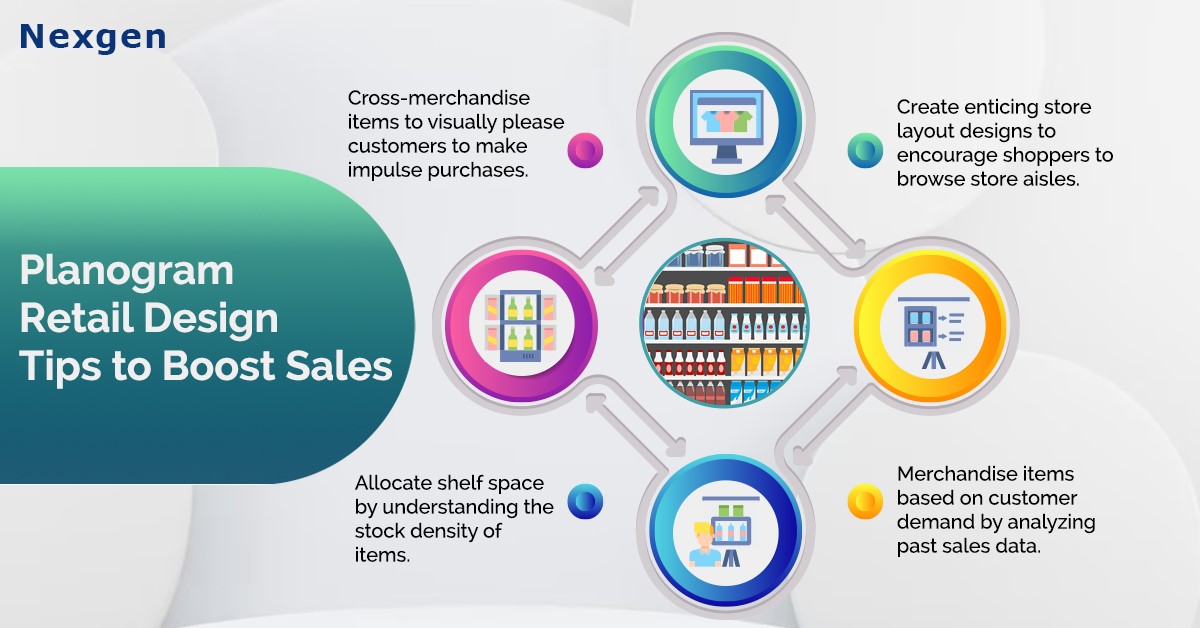As a retailer, it takes a lot of hard work and dedication to keep your business running. While there are many aspects of your retail business that require attention, the most important aspect is your store design and sales.
Retail design has always been an essential part of retail store strategy. But these days, it is more important than ever to boost sales. If you are running a brick-and-mortar store, it is important that you take some time to plan your merchandise to maximize sales. Humans are known to be highly visual. Since the brain receives around 90% of its information from the eyes, displaying visually attractive and appealing shelves can help draw customer attention. Therefore, a key strategy to boost store sales is to focus on visual merchandising using planogram software. Planograms allow retailers to set themselves apart from their competitors through shelf planning, product placement, or in-store design. The following are some retail merchandising ideas that help boost sales:

- Create an immersive in-store experience: Retail design is not just about well-curated displays or attractive visual merchandising. It is about the experience that you create for your shoppers to make their shopping experience attractive and interesting. You need to be more careful when displaying products on shelves. This is why your retail data-driven information about your shopper’s likes, preferences, and lifestyle choices is important. Viewing your merchandise from the shopper’s perspective will also help you get ideas for cross-merchandising. Placing too many products can create confusion among shoppers in choosing products, which can result in a loss of sales.
- Set store layout design based on customer traffic: If you want customers to see your best-selling items or displays first, you need to know where they go or turn to when they visit your store. Do they tend to move to the right or the left? Where do their eyes fall first when they see your store? These are some questions that you need to consider when merchandising your store. Studies have reported that the pattern of movement of shoppers in supermarkets is counterclockwise in the U.S., but in the U.K., Australia, and Japan, there is a great chance that shoppers move in a clockwise pattern. Placing your best-selling items on window displays will help you create a great impression on shoppers. Since your window displays are the first thing shoppers see when they visit your store, placing your best-selling products or themed items on them can attract shoppers. For example, jackets or warm clothing with winter themes can be placed during the winters.
- Merchandise with your shopper's mind: You can only be successful when you satisfy your customers with the right merchandise. For example, if you are an apparel retailer, you need to think about some factors. Why do your customers visit your store? Are they looking for casual wear or something for a special occasion? Are there specific categories that they are looking for? Create a clear store layout design using store displays and signage to highlight the products or discounts they are searching for. To understand how they shop in any given category, one needs to identify the customer decision tree by examining past sales data using planograms. For example, if shoppers buy shirts primarily based on style, ensure that the shirts are displayed first by style to increase the chances of impulse buying.
- Allocate shelf space with care: As a retailer, you need to understand the stock density and the point at which items are displayed with enough space to sell. For example, a display of 15 socks may sell fast, but the same socks on a display of just two may not sell at all. Maintaining visual impact and shelf placement is essential for utilizing the space allotted to display merchandise. A display of 25 pairs of socks may not increase sales further.
- Grouping items to boost sales: The right merchandising can quickly fill the shopper’s basket and expose them to other items within the store. You can group complementary items together to increase sales. Retailers can group products in various ways. For example, consider grouping products that have a natural relation with one another. Placing heavy jackets and scarves can make your shopper think about what else they need to purchase before they head to the checkout counters. You can also inspire shoppers by displaying outfits with jewelry or other accessories. For instance, placing sunglasses next to dresses, or a relevant collection of belts with jeans.
Overview of Nexgen POG
Nexgen POG is a robust and user-friendly cloud-based visual merchandising tool. It is designed for quick and efficient planogramming with minimal effort. Planogram in retail can be designed by easily dragging and dropping the products. The multi-device compatibility feature of POG allows you to obtain, share and edit planogram on any device, including your phone. It helps in designing store-specific planograms for increased product visibility and sales.
Get Your Free Trial Now!